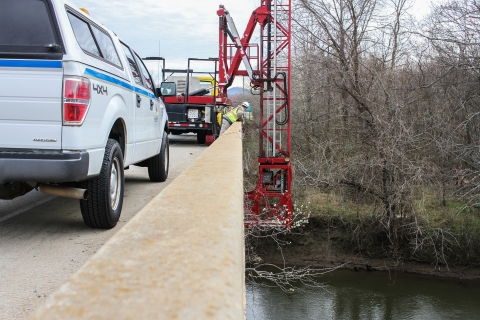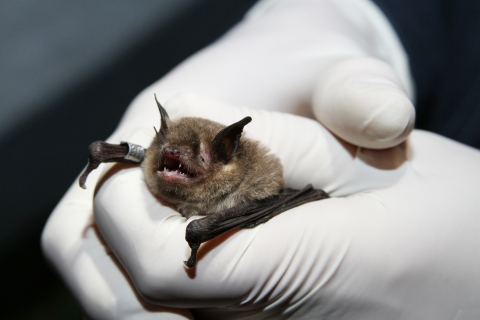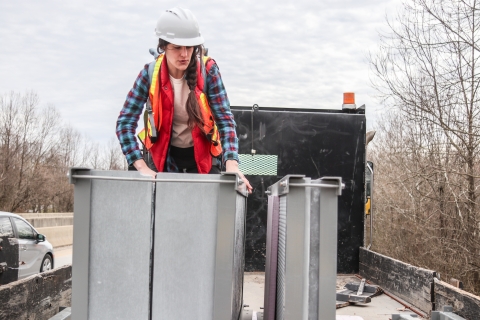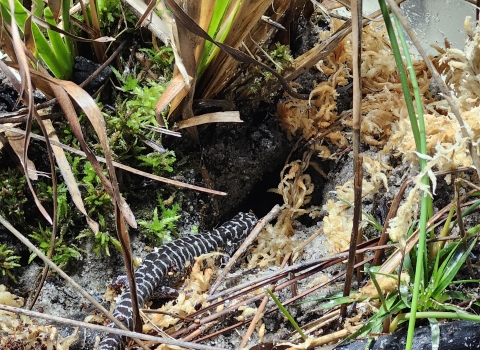Asheville N.C. - On a March day, traffic slowed along a highway outside Asheville, N.C. as two lanes merged together to pass an N.C. Department of Transportation crew on a bridge over the French Broad River. It wasn’t maintenance – the road and bridge are in fine shape. It was part of the balancing act between conserving one of the nation’s rarest animals and meeting the transportation needs of a growing population in the Asheville metropolitan area.
Beneath the bridge, NCDOT biologist (yes, the NCDOT has biologists) Chris Manley and a local DOT crew were installing roosting structures for one of the rarest bats in the United States. While the highway is a major transportation corridor in the greater Asheville area, what lies beneath the bridge, the French Broad River, is also a major transportation corridor —for endangered gray bats.
Once an anomaly in western North Carolina, the area’s gray bat population has soared in recent years. Gray bat success in western North Carolina is a ray of good news when bat conservation over the last 15 years has been hampered by white-nose syndrome, a fungal disease typically fatal in several species of bats, but one to which the gray bat does not succumb.
The bats roost in culverts and bridges as they travel the French Broad River corridor. In fact, a chance encounter between a bat and a wildlife biologist on a bridge across the French Broad River south of Asheville triggered additional examination of the species in western North Carolina. The discovery of gray bats on that bridge prompted searches from Avery County to Haywood County. At the beginning of 2016 there were no known gray bat roosts in North Carolina. Today there are nearly 40.
“The surge in western North Carolina gray bat numbers is cause for celebration,” said Service biologist Sue Cameron, who has worked with North Carolina bats for years. “We want to continue that trend, therefore we’re reminded to take a closer look at how our actions impact these bats.”
Planning for the widening of I-26 in Buncombe and Henderson counties included extensive conversations between NCDOT and the U.S. Fish and Wildlife Service about minimizing negative impacts to federally threatened or endangered species that may be affected by the construction – including gray bats. These conversations led to the artificial roosts. Biologists were concerned that construction, which included bridge and culvert work, could cause some, or even all, of the bats to abandon the area. The solution included providing ample and appealing roost structures in areas outside the construction zone. In total, Manley, fellow NCDOT biologist Cheryl Knepp, and local crews installed four roost structures on bridges spanning the French Broad River.
“We learned through rigorous acoustic surveys along the entire project corridor that a significant portion of the gray bat population in the area was using the French Broad River as a foraging and commuting corridor,” said Marissa Cox, head of NCDOT’s Biological Surveys Group. “Investigating emerging technologies with the Service led to the decision to install the first artificial bat roost panels on North Carolina bridges. Continuing to foster the partnership and coordination is the only way we can bridge the divide between endangered species habitat needs and human transportation needs.”
The NCDOT isn’t the only organization installing the roosting structures. The newly constructed bridge across the French Broad River providing access to Biltmore Farms property and Asheville’s Pratt & Whitney plant also incorporates dedicated bat roosts.
"With the area’s growth and the increasing traffic on roadways and on the French Broad River, it's encouraging to see how working in partnership across agencies and organizations can benefit rare species,” said Service biologist Holland Youngman, who works closely with the NCDOT. “What we’re also seeing is increasing recognition of the river’s ecological importance, especially as a home to some of our most imperiled animals.”
While these bat roosting structures have been used extensively in the west, their installation along the French Broad River marks the first attempt to use these in the eastern United States. Manufactured by a small, New Mexico-based company, the roosts follow two different designs. A standard box is constructed like a larger, more durable bat box – it contains flat, but textured, panels the bats can hold onto. The other design mimics a small cave – again, from the outside it appears to be a large, durable box, but inside is a chamber that was molded to actual rock face — box on the outside, tiny cave on the inside. Both are constructed of concrete, which can retain heat and mimic conditions they seek out in bridges and culverts. The roosting structures will be monitored in the coming years to see if the bats take to their new homes.







